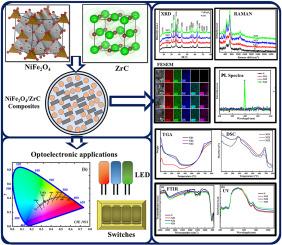Crystallographic modulation and optoelectronic phenomena in NiFe2O4/ZrC composites: A multifaceted structural and spectroscopic exploration
IF 4.2
3区 材料科学
Q2 MATERIALS SCIENCE, MULTIDISCIPLINARY
引用次数: 0
Abstract
This work investigates the structural and optoelectronic properties of nickel ferrite (NFO) composites with varying zirconium carbide (ZrC) content using x-ray diffraction (XRD), field emission scanning electron microscopy (FESEM), Raman spectroscopy, thermogravimetric/differential scanning calorimetry (TGA/DSC), ultraviolet–visible (UV–Vis), and photoluminescence (PL) spectroscopy. XRD confirms a cubic spinel NFO structure with emerging ZrC rock-salt peaks, while crystallite sizes (13–22 nm) and microstrain (10−5–10−3) reveal lattice strain and defect incorporation. FESEM shows morphological evolution from porous NFO aggregates to dense ZrC-rich composites, and elemental mapping affirms homogeneous Ni, Fe, O, Zr, and C distribution. Raman spectra exhibit A1g phonon modes (600–700 cm−1) alongside ZrC-related bands (200–400 cm−1), indicating phonon coupling and phase coexistence. TGA/DSC demonstrates improved thermal stability, with transitions between 400 and 600 °C linked to enthalpy changes. Optical studies reveal a bandgap redshift from 1.88 eV to 1.61 eV, supported by Tauc plots and dielectric analysis. PL spectra display enhanced blue emission at ∼425 nm, associated with efficient defect-mediated recombination. Chromaticity analysis shows bluish-white emission with correlated colour temperatures (6297–6318 K) and a stable colour rendering index (∼89). The combined influence of lattice strain, phonon dynamics, and electronic transitions highlights the promise of NFO–ZrC composites for optoelectronic and photonic applications.

NiFe2O4/ZrC复合材料的晶体调制和光电子现象:一个多方面的结构和光谱探索
本文采用x射线衍射(XRD)、场发射扫描电镜(FESEM)、拉曼光谱、热重/差示扫描量热法(TGA/DSC)、紫外可见(UV-Vis)和光致发光(PL)光谱研究了不同碳化锆(ZrC)含量的铁酸镍(NFO)复合材料的结构和光电性能。XRD证实为立方尖晶石NFO结构,并出现ZrC岩盐峰,晶粒尺寸(13 ~ 22 nm)和微应变(10 ~ 10 ~ 3)显示晶格应变和缺陷掺入。FESEM显示了从多孔的NFO聚集体到致密的富zrc复合材料的形态演变,元素映射证实了Ni、Fe、O、Zr和C的均匀分布。拉曼光谱呈现A1g声子模式(600-700 cm−1)和zrc相关波段(200-400 cm−1),表明声子耦合和相共存。TGA/DSC显示了更好的热稳定性,400到600°C之间的转变与焓变化有关。光学研究表明,在tac图和介电分析的支持下,带隙红移从1.88 eV到1.61 eV。PL光谱在~ 425 nm处显示出增强的蓝色发射,这与有效的缺陷介导重组有关。色度分析显示蓝白色发射具有相关色温(6297-6318 K)和稳定的显色指数(~ 89)。晶格应变、声子动力学和电子跃迁的综合影响突出了NFO-ZrC复合材料在光电和光子应用方面的前景。
本文章由计算机程序翻译,如有差异,请以英文原文为准。
求助全文
约1分钟内获得全文
求助全文
来源期刊

Optical Materials
工程技术-材料科学:综合
CiteScore
6.60
自引率
12.80%
发文量
1265
审稿时长
38 days
期刊介绍:
Optical Materials has an open access mirror journal Optical Materials: X, sharing the same aims and scope, editorial team, submission system and rigorous peer review.
The purpose of Optical Materials is to provide a means of communication and technology transfer between researchers who are interested in materials for potential device applications. The journal publishes original papers and review articles on the design, synthesis, characterisation and applications of optical materials.
OPTICAL MATERIALS focuses on:
• Optical Properties of Material Systems;
• The Materials Aspects of Optical Phenomena;
• The Materials Aspects of Devices and Applications.
Authors can submit separate research elements describing their data to Data in Brief and methods to Methods X.
 求助内容:
求助内容: 应助结果提醒方式:
应助结果提醒方式:


